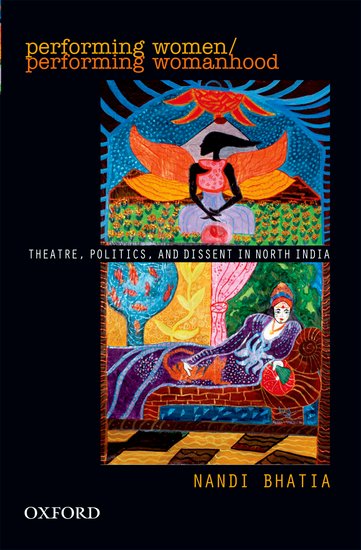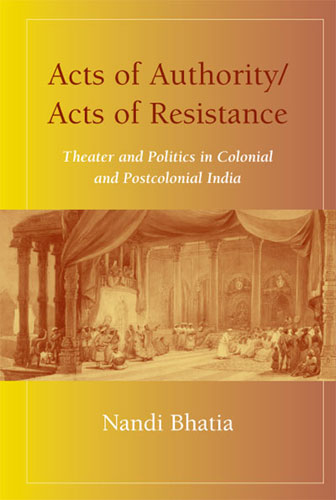Abstract: This play tells the story of Azizun Nisa, a courtesan who left her profession during the 1857 Sipahi revolt to become a soldier and fight the British.
Category: Plays
Ali, Kamran Asdar. “Courtesans in the Living Room.” ISIM Review, Vol. 15, 2005, pp. 32-33.
This article is open-source and can be freely downloaded here.
Summary
In the spring of 2003, Pakistan’s GeoTV ran its first serialized television play: Umrao Jan Ada, based on the novel of the same name. (This novel also spawned films in 1981 and 2006, both named Umrao Jaan.)
This article examines questions about how this series, and popular television performances like it, reflect and facilitate discourse on gender politics in present-day Pakistan. The courtesan has long been a stock character in South Asian popular culture, including literature and film, but its recent proliferation is of particular interest: as the author asks, “Why have Pakistan’s liberal intelligentsia and feminists chosen at this juncture to depict the life-world of the prostitute and the figure of the courtesan as metaphors to argue for sexual freedom and women’s autonomy?” (32).
In short, Ali argues that the film’s representation of the Nawabi era as tolerant and inclusive confronts and challenges the “more homogenizing elements of Islamic politics in [modern-day] Pakistani society.” He also addresses the issue of linguicism within the play: while it confronts issues of sexism and inclusivity, it does so localized entirely within the space of high Urdu culture, “and in doing so remains oblivious to the vital issues of cultural and linguistic diversity within Pakistan” (33).
Dattani, Mahesh. Dance Like a Man: A Stage Play in Two Acts. Penguin, 2006.
Jairaj Parekh and his wife Ratna, aging Bharatnatyam dancers, live together in the home of Jairaj’s father, Amritlal. Having retired from an unfulfilling career, Jairaj and Ratna project their hopes for higher achievement onto their daughter, Lata, also a dancer. Generational conflicts abound: Lata attempts to balance her parents’ ambitions with her desire to marry her boyfriend, Viswas; meanwhile, Jairaj and Ratna struggle to work through their longstanding conflict with Amritlal, once a nationalist activist and now a conservative reactionary, who views dancing as the work of prostitutes and whose rigid views of manhood are constantly challenged by his artistic, expressive son. A movie based on the play was released in 2014.
While devadasis are not protagonists in this play, they are nevertheless thematically central: pre-Indian independence, Bharatanatyam was largely performed by devadasis, but the devadasi practice was shamed and outlawed during the Indian nationalist movement as an effort to appeal to colonial conceptions of gender and civility. (Indeed, Amritlal forbids Jairaj from learning dance from a local Devadasi.) This careful exclusion and suppression of female public performers and their associated traits informs much of Amritlal’s character, and by extension, much of the play’s conflict.
Consider the following questions:
- Amritlal, once an activist for the cause of freeing India from British occupation, nevertheless enforces strict binary gender roles. Do these seemingly-contradictory political stances mean Amritlal used to be progressive and is now conservative? Can he be both at one time?
- To what degree can Amritlal be forgiven for his sexism if sexism helped to achieve India’s independence? Similarly, to what degree should women and other marginalized groups be expected to bear oppression in the name of progress? Can progress ever be simple, linear, and teleological?
- In presenting Bharatanatyam as a worthy art form for all genders and non-devadasi dancers, does the narrative appear to validate the devadasi practice, devadasis themselves, and/or devadasis’ artistic skills? Alternatively, is the dance form separated from the devadasis? What assumptions are made about devadasis, if any?
Bhatia, Nandi. Performing Women/ Performing Womanhood: Theatre, Politics and Dissent in North India. Oxford University Press, 2010.
This book was longlisted for the 2011 Vodafone Crossword Book Award.
Official Summary: This book brings visibility to the work of women who performed on the borderlines of dominant theatrical activity and engaged in dramatic enactments that contested middle-class codes of female propriety, which became normalized in the national popular consciousness. It recovers, excavates, and remembers the contribution of the neglected as well as known figures in theatre history from north India, in languages which include Hindi, Urdu, and Punjabi, and cements their place in the canon of Indian theatre. It examines the diverse modes of dramatic representation and performance — myth, folklore, ritual, and history, including everyday conversation — used by women to intervene in and challenge the agenda of social movements, which conceptualized women’s emancipation but imagined their role as being primarily at the core of family life. The author argues that women’s presence on stage and their involvement in theatre — as actors, playwrights, directors, organizers, and characters — made important contributions to the debates on gender and nationalism at particular moments of colonial and postcolonial history.
Bhatia, Nandi. Acts of Authority/ Acts of Resistance: Theatre and Politics in Colonial and Postcolonial India. U of Michigan P, 2004. (Republished by Oxford University Press, 2004.)
Official Summary: Despite its importance to literary and cultural texts of resistance, theater has been largely overlooked as a field of analysis in colonial and postcolonial studies. Acts of Authority/Acts of Resistance seeks to address that absence, as it uniquely views drama and performance as central to the practice of nationalism and anti-colonial resistance.
Nandi Bhatia argues that Indian theater was a significant force in the struggle against oppressive colonial and postcolonial structures, as it sought to undo various schemes of political and cultural power through its engagement with subjects derived from mythology, history, and available colonial models such as Shakespeare. Bhatia’s attention to local histories within a postcolonial framework places performance in a global and transcultural context. Drawing connections between art and politics, between performance and everyday experience, Bhatia shows how performance often intervened in political debates and even changed the course of politics.
One of the first Western studies of Indian theater to link the aesthetics and the politics of that theater, Acts of Authority/Acts of Resistance combines in-depth archival research with close readings of dramatic texts performed at critical moments in history. Each chapter amplifies its themes against the backdrop of specific social conditions as it examines particular dramatic productions, from The Indigo Mirror to adaptations of Shakespeare plays by Indian theater companies, illustrating the role of theater in bringing nationalist, anticolonial, and gendered struggles into the public sphere.
De Bruin, Hanne M. “Naming a Theatre in Tamil Nadu.” Asian Theatre Journal, vol. 17, no. 1, 2000, pp. 98–122
In this article, Hanne M. de Bruin examines the issues surrounding the name for the folk theatre of Tamil Nadu, India — usually known as terukkuttu (one of several possible spellings), but which some now prefer to call kattaikkuttu. De Bruin’s position as a theatre researcher not only gives her firsthand insights based on her own participation in the debate but, as she notes, also clouds the issues because of her status as a foreign scholar. In her essay, De Bruin closely examines the sociopolitical ramifications of the naming problem.


